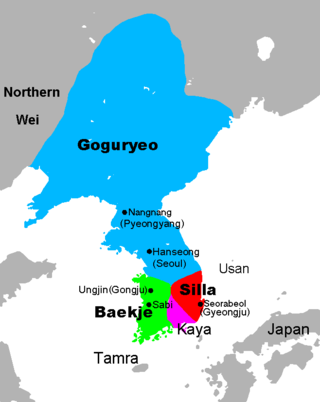| Goguryeo | |
|---|---|
| Koguryŏ | |
| Native to | Goguryeo, Balhae? |
| Region | Manchuria, Korea |
| Extinct | 7th–10th century? |
| Language codes | |
| ISO 639-3 | zkg |
zkg | |
| Glottolog | kogu1234 |
 The Three Kingdoms of Korea, with Goguryeo and Buyeo in blue (Kaya is not included in the Three Kingdoms) | |
The Goguryeo language, or Koguryoan, was the language of the ancient kingdom of Goguryeo (37 BCE – 668 CE), one of the Three Kingdoms of Korea. Early Chinese histories state that the language was similar to those of Buyeo, Okjeo and Ye. Lee Ki-Moon grouped these four as the Puyŏ languages. The histories also stated that these languages were different from those of the Yilou and Mohe. All of these languages are unattested except for Goguryeo, for which evidence is limited and controversial.[1]
The most cited evidence is a body of placename glosses in the Samguk sagi. Most researchers in Korea, assuming that the people of Goguryeo spoke a dialect of Old Korean, have treated these words as Korean, while other scholars have emphasized similarities with Japonic languages.[2] Lee and Ramsey suggest that the language was intermediate between the two families.[3] Other authors suggest that these placenames reflect the languages of other peoples in the part of central Korea captured by Goguryeo in the 5th century, rather than Goguryeo itself.
Other evidence is extremely sparse, and is limited to peculiarities in the Chinese language of Goguryeo inscriptions and a very few Goguryeo words glossed in Chinese texts. Vovin and Unger suggest that it was the original form of Koreanic, which subsequently replaced Japonic languages in the south of the peninsula.[4][5] Others maintain that it was Tungusic, or that there is insufficient evidence to establish its affiliation.
- ^ Lee & Ramsey (2011), pp. 34–35.
- ^ Lee & Ramsey (2011), pp. 43–44.
- ^ Lee & Ramsey (2011), p. 44.
- ^ Vovin (2013), pp. 231–232.
- ^ Unger (2009), p. 87.